Abstract
An unusual abundance of Salmonella infections was studied in an island population of a wild marsupial, the quokka (Setonix brachyurus), which experiences starvation in summer associated with significant mortality. The frequency of infections was found to vary seasonally over most parts of the island, with high infection rates (70 to 100%) in summer and low infection rates (0 to 30%) in winter. In some samples, there was an average of as many as two isolations per animal, and up to five isolations were made from a single animal. By the end of summer, virtually all animals excreted Salmonella spp., with a median rate of excretion of approximately 3,000 Salmonella organisms per g of feces. The seasonal changes occurred over intervals of only weeks. The infections are believed to be associated with disruption of the digestive physiology of the animals caused by the poor quality of feed available in summer. This conclusion was supported by a quantitative study of the infections and by a field manipulation experiment which delayed the initiation of the infections as long as a food supplement was available. The proliferation of Salmonella spp. is discussed in terms of the ecology of the quokka and of the use of Salmonella spp. as indicators of environmental stress acting on the animals.
Full text
PDF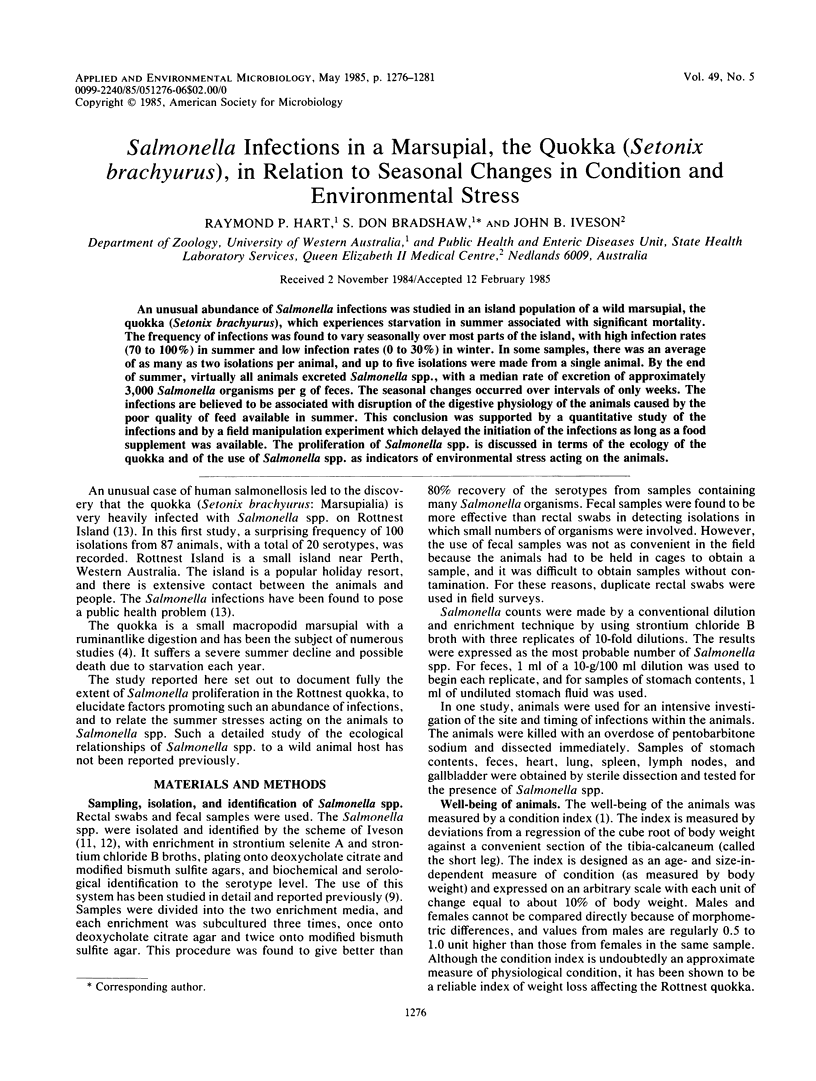
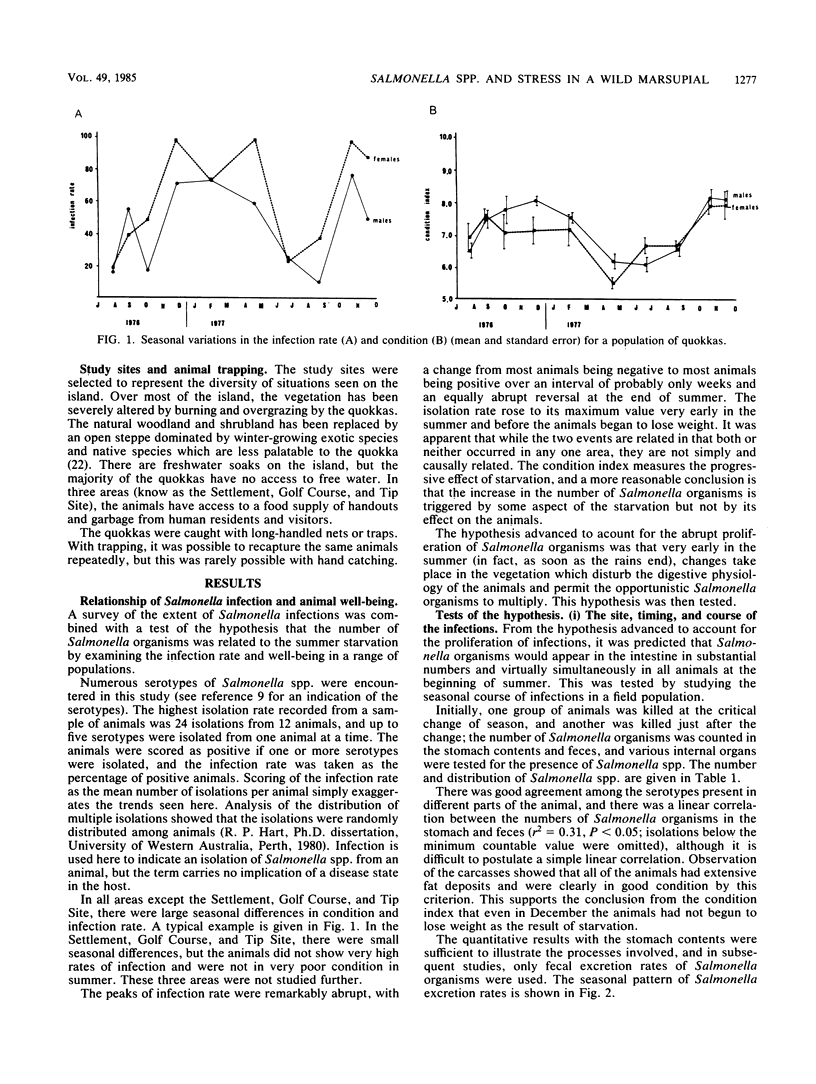

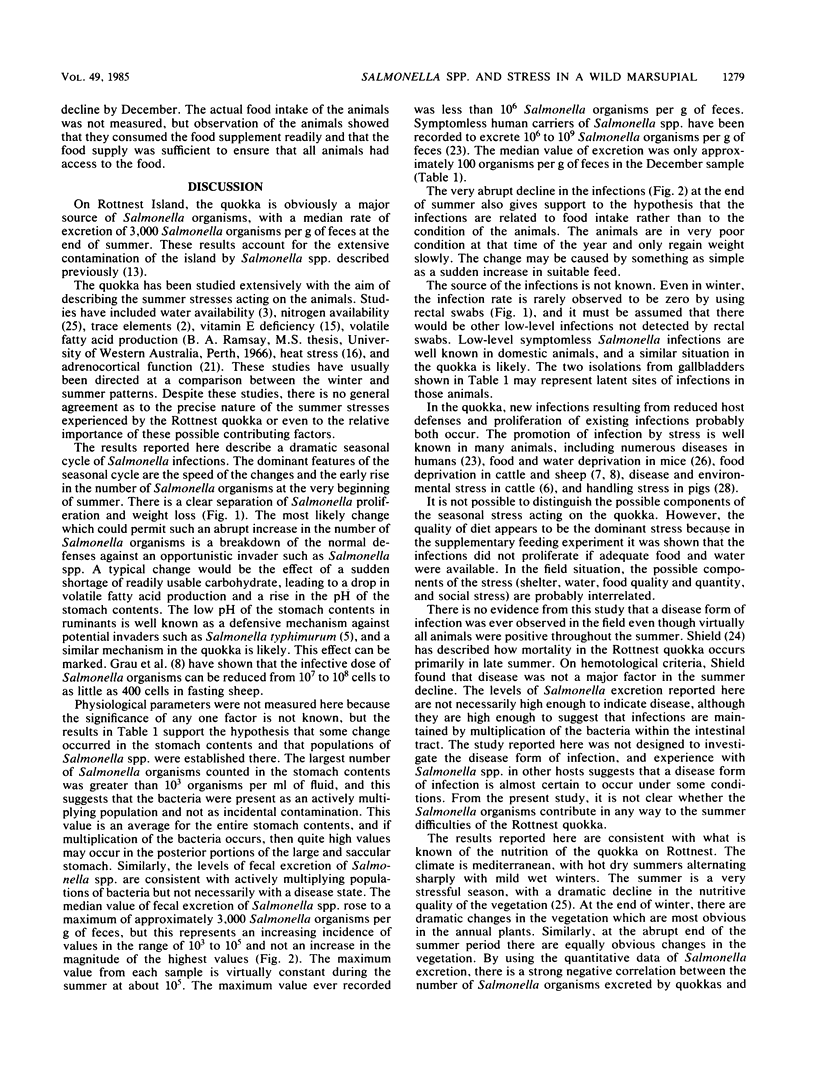
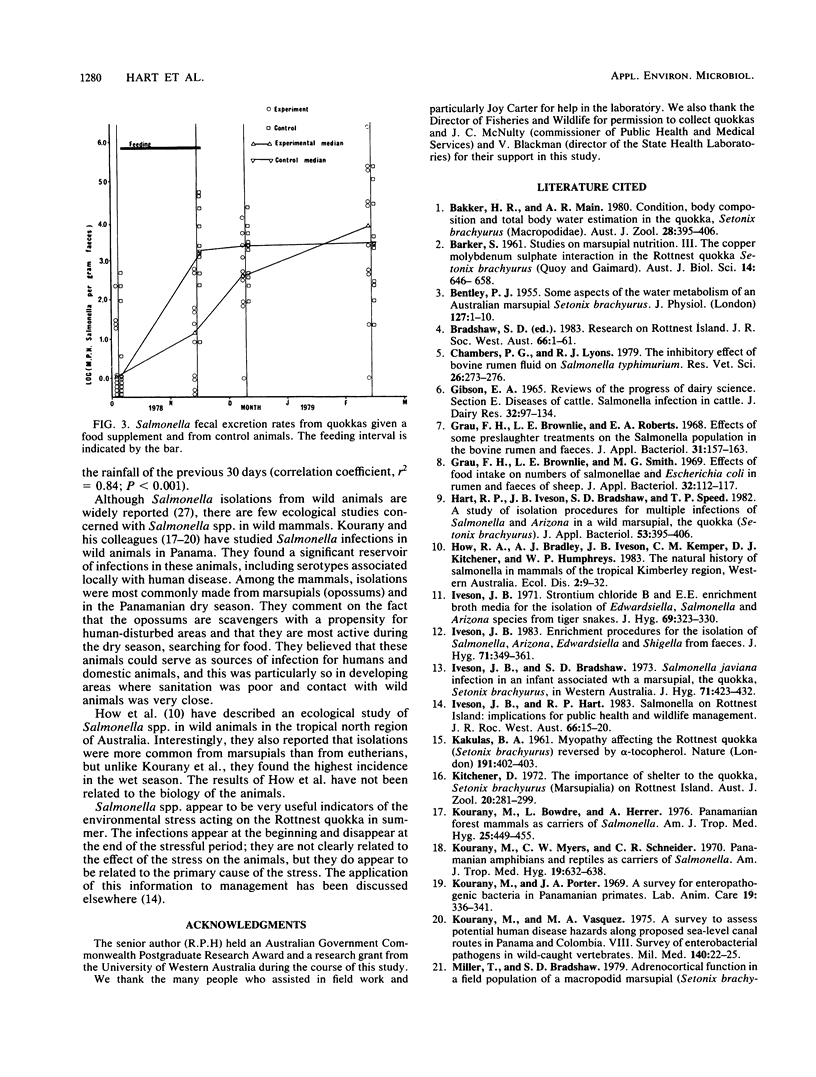
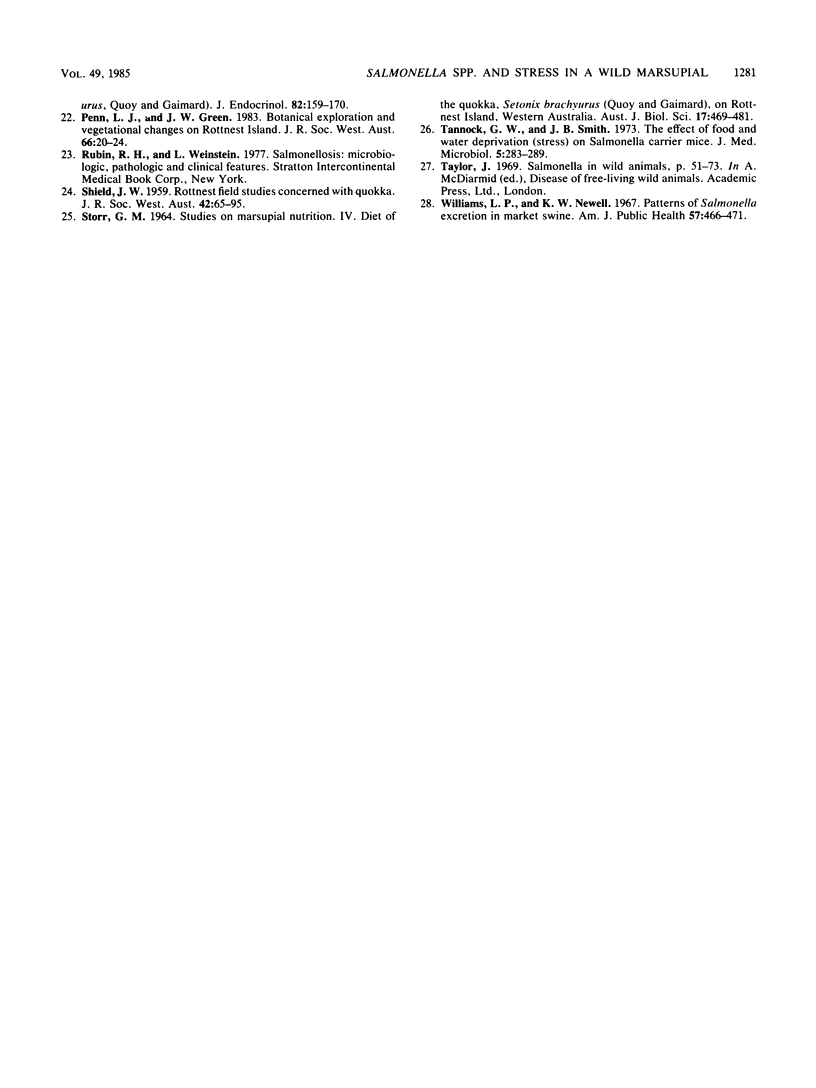
Selected References
These references are in PubMed. This may not be the complete list of references from this article.
- BENTLEY P. J. Some aspects of the water metabolism of an Australian marsupial Setonyx brachyurus. J Physiol. 1955 Jan 28;127(1):1–10. doi: 10.1113/jphysiol.1955.sp005234. [DOI] [PMC free article] [PubMed] [Google Scholar]
- Chambers P. G., Lysons R. J. The inhibitory effect of bovine rumen fluid on Salmonella typhimurium. Res Vet Sci. 1979 May;26(3):273–276. [PubMed] [Google Scholar]
- Grau F. H., Brownlie L. E., Roberts E. A. Effect of some preslaughter treatments on the Salmonella population in the bovine rumen and faeces. J Appl Bacteriol. 1968 Mar;31(1):157–163. doi: 10.1111/j.1365-2672.1968.tb00353.x. [DOI] [PubMed] [Google Scholar]
- Grau F. H., Brownlie L. E., Smith M. G. Effects of food intake on numbers of salmonellae and Escherichia coli in rumen and faeces of sheep. J Appl Bacteriol. 1969 Mar;32(1):112–117. doi: 10.1111/j.1365-2672.1969.tb02195.x. [DOI] [PubMed] [Google Scholar]
- Hart R. P., Iveson J. B., Bradshaw S. D., Speed T. P. A study of isolation procedures for multiple infections of Salmonella and Arizona in a wild marsupial, the quokka (Setonix brachyurus). J Appl Bacteriol. 1982 Dec;53(3):395–406. doi: 10.1111/j.1365-2672.1982.tb01288.x. [DOI] [PubMed] [Google Scholar]
- How R. A., Bradley A. J., Iveson J. B., Kemper C. M., Kitchener D. J., Humphreys W. F. The natural history of salmonellae in mammals of the tropical Kimberley region, Western Australia. Ecol Dis. 1983;2(1):9–32. [PubMed] [Google Scholar]
- Iveson J. B., Bradshaw S. D. Salmonella javiana infection in an infant associated with a marsupial, the quokka, Setonix brachyurus, in Western Australia. J Hyg (Lond) 1973 Sep;71(3):423–432. doi: 10.1017/s0022172400046404. [DOI] [PMC free article] [PubMed] [Google Scholar]
- Iveson J. B. Enrichment procedures for the isolation of Salmonella, Arizona, Edwardsiella and Shigella from faeces. J Hyg (Lond) 1973 Jun;71(2):349–361. doi: 10.1017/s0022172400022804. [DOI] [PMC free article] [PubMed] [Google Scholar]
- Iveson J. B. Strontium chloride B and E.E. enrichment broth media for the isolation of Edwardsiella, Salmonella and Arizona species from tiger snakes. J Hyg (Lond) 1971 Sep;69(3):323–330. doi: 10.1017/s0022172400021562. [DOI] [PMC free article] [PubMed] [Google Scholar]
- KAKULAS B. A. Myopathy affecting the Rottnest quokka (Setonix brachyurus) reversed by alpha-tocopherol. Nature. 1961 Jul 22;191:402–403. doi: 10.1038/191402a0. [DOI] [PubMed] [Google Scholar]
- Kourany M., Bowdre L., Herrer A. Panamanian forest mammals as carriers of Salmonella. Am J Trop Med Hyg. 1976 May;25(3):449–455. doi: 10.4269/ajtmh.1976.25.449. [DOI] [PubMed] [Google Scholar]
- Kourany M., Myers C. W., Schneider C. R. Panamanian amphibians and reptiles as carriers of Salmonella. Am J Trop Med Hyg. 1970 Jul;19(4):632–638. doi: 10.4269/ajtmh.1970.19.632. [DOI] [PubMed] [Google Scholar]
- Kourany M., Porter J. A., Jr A survey for enteropathogenic bacteria in Panamanian primates. Lab Anim Care. 1969 Jun;19(3):336–341. [PubMed] [Google Scholar]
- Kourany M., Vásquez M. A. A survey to assess potential disease hazards along proposed sea level canal routes in Panamá and Colombia. VIII. Survey of enterobacterial pathogens in wild-caught vertebrates. Mil Med. 1975 Jan;140(1):22–25. [PubMed] [Google Scholar]
- Miller T., Bradshaw S. D. Adrenocortical function and a field population of a macropodid marsupial (Setonix brachyurus, Quoy and Gaimard). J Endocrinol. 1979 Jul;82(1):159–170. doi: 10.1677/joe.0.0820159. [DOI] [PubMed] [Google Scholar]
- Tannock G. W., Smith J. M. The effect of food and water deprivation (stress) on Salmonella-carrier mice. J Med Microbiol. 1972 Aug;5(3):283–289. doi: 10.1099/00222615-5-3-283. [DOI] [PubMed] [Google Scholar]
- Williams L. P., Jr, Newell K. W. Patterns of Salmonella excretion in market swine. Am J Public Health Nations Health. 1967 Mar;57(3):466–471. doi: 10.2105/ajph.57.3.466. [DOI] [PMC free article] [PubMed] [Google Scholar]


